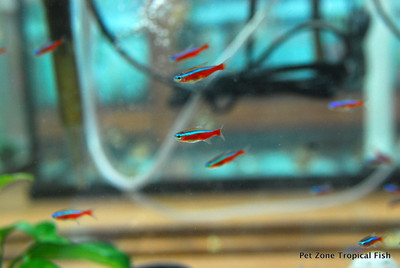Cardinal Tetra
Posted by Max Gandara on on 7th May 2025
Cardinal Tetra: The Living Jewel of the Amazon
If there's one fish that perfectly combines beauty, tranquility, and community spirit, it's the Cardinal Tetra (Paracheirodon axelrodi). With their electric blue stripes and vibrant red undersides, these tiny freshwater fish are a favorite in aquariums around the world — and for good reason.
A Glimpse into the Wild
Cardinal Tetras are native to the blackwater rivers of South America, primarily in the Amazon Basin across Brazil, Venezuela, and Colombia. In the wild, they school in large numbers in soft, acidic, tannin-rich waters beneath dense jungle canopies. Their vivid colors not only help them blend into the shimmering dappled light of their native environment but also act as a warning to predators that they are not easy prey.
Appearance
The Cardinal Tetra is a visual stunner. It features:
-
A brilliant neon blue stripe running horizontally from its eye to the base of its tail
-
A bold red stripe that runs the length of its body, from under the gills to the tail (unlike the Neon Tetra, where the red is only half-length)
-
A small, slender body, growing up to 5 cm (2 inches)
Their striking coloration makes them a centerpiece in community aquariums, especially when kept in a school.
Behavior and Temperament
Cardinal Tetras are peaceful, schooling fish that thrive in groups of at least 6–10, but the more, the better. When kept in larger numbers, they exhibit more natural behaviors and feel safer — their schooling movement is mesmerizing to watch.
They're shy by nature and get along well with other small, non-aggressive species like:
-
Corydoras catfish
-
Dwarf gouramis
-
Rasboras
-
Other peaceful tetras
Aquarium Setup
While not particularly difficult to care for, Cardinal Tetras do best when their tank mimics their natural habitat:
-
Tank size: Minimum 15–20 gallons for a school
-
Temperature: 23–28°C (73–82°F)
-
pH: 4.5–7.0 (they prefer acidic water)
-
Hardness: Soft to moderately soft
-
Substrate: Dark sand or fine gravel
-
Décor: Driftwood, live plants, and leaf litter to create shaded areas and tannin-rich water
-
Lighting: Low to moderate
Keeping the water clean and stable is critical, as they are sensitive to poor water conditions.
Diet
Cardinal Tetras are omnivores and enjoy a varied diet:
-
High-quality micro pellets and flakes
-
Frozen or live foods like daphnia, bloodworms, and brine shrimp
-
Occasional blanched vegetables or spirulina-based foods
Feeding small amounts 1–2 times per day will keep them vibrant and healthy.
Breeding Challenges
Breeding Cardinal Tetras is considered difficult, even for experienced aquarists. They require:
-
Soft, acidic water (pH around 5.0–6.0)
-
Very dim lighting
-
A separate breeding tank with fine-leaved plants or spawning mops
Males and females will pair off, and the female can lay up to 500 eggs. The fry are extremely light-sensitive in their early days and need specialized care.
Cardinal Tetra vs. Neon Tetra
A common question: How is the Cardinal Tetra different from the Neon Tetra?
-
Cardinal Tetra: Red stripe extends the entire length of the body
-
Neon Tetra: Red stripe only goes halfway
Cardinals also tend to be slightly larger and more vibrant, and they prefer warmer, more acidic water than Neons.
Why Choose Cardinal Tetras?
-
Stunning coloration
-
Peaceful and great for community tanks
-
Schooling behavior adds life and movement
-
Compatible with planted or blackwater aquascapes
Final Thoughts
The Cardinal Tetra is a true gem of the freshwater aquarium hobby. While they may require a bit more attention to water parameters than beginner fish, the payoff is well worth it. Their glowing appearance and peaceful nature make them a perfect choice for anyone looking to create a vibrant, natural-looking aquarium.

